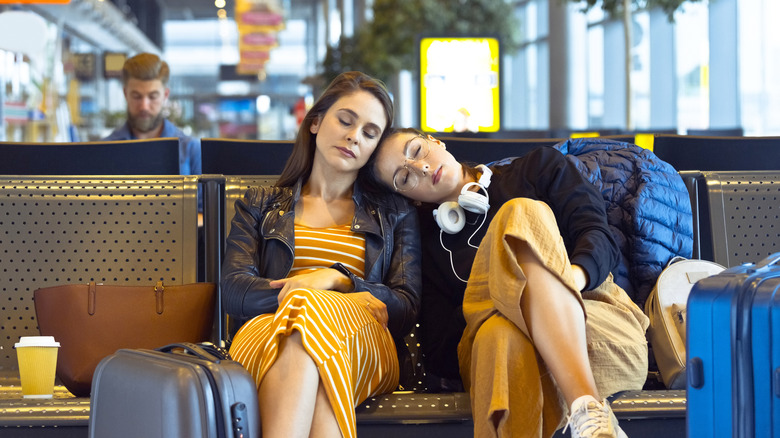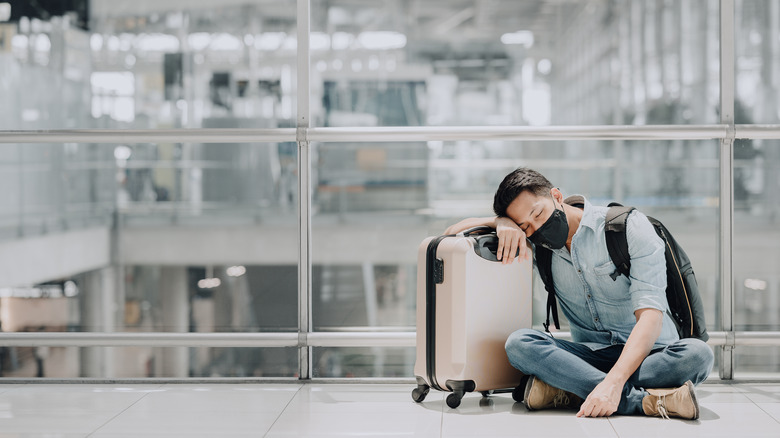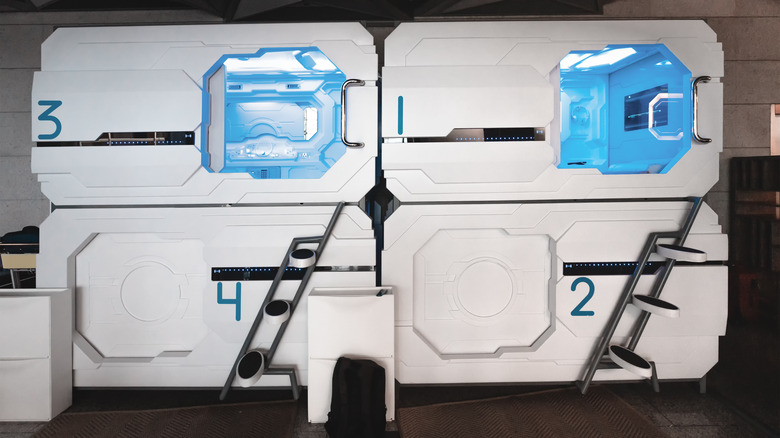What To Know Before Taking A Nap In The Airport During Long Layovers
Most international travelers will agree: There are few things as annoying and inconvenient as a long layover. You know the type, right? Layovers that feel long enough to bore the daylights out of you... but not long enough to actually force you to leave the airport — especially when said layover is in the middle of the night or in the early hours of the morning. Left standing there, stuck between home and your destination, the question of how to spend your time and what to do with all these tedious hours comes up.
And while finding ways to pass the time can be a challenge, there are certain things you should try to keep in mind. One of those is as simple as choosing where — and how — to take a much-needed nap. Luckily, whether it's cozying up on the floor, grabbing a row of benches all to yourself, or finding a quiet corner, there aren't any official rules that dictate how you're allowed to nap while waiting for your flight. It's all up to personal preference — and basic airport etiquette.
So what exactly is the etiquette when it comes to taking a nap at the airport? Should you settle into a chair and hope for the least amount of neck pain? And can you get kicked out for making a bed out of hoodies and folded-up socks for a snooze on the floor?
No, you won't get in trouble...
Being that there aren't any hard-and-fast rules that say you can't sleep on the airport floor or use the benches during nap time, there's nothing to worry about in terms of breaking the law. Even if you're sprawled out and snoring, airport security won't interrupt your slumber as long as you're not in the way of operations and have a valid boarding pass that confirms you're departing from the airport and not just using it as a crash pad. Needless to say, if you're trying to live out your Tom Hanks "Terminal" fantasy — including waltzing around in your boxers or using the sink to shower — you'll probably get the boot or a stern warning.
Nonetheless, it's also important to keep in mind that certain airports have different rules. Some airports, for example, close at nighttime. This means that you actually have to leave the premises until it reopens. Others, like Boston Logan International Airport, shut down the "secure zone" for the night, and require travelers to move out while it's not operational. While these practices aren't that common, knowing where you stand in terms of rules and regulations before you've even landed can make the difference between being left out in the cold and putting together a cozy plan beforehand.
Look for alternatives
Sleeping on the floor might seem like the most convenient way to catch some shut-eye, but it's definitely not the only one. Nowadays, most major airports are equipped with dedicated zones that make long layovers a lot more bearable. Whether it's private sleeping pods — available to rent directly at the airport that can cost as little as $10 per hour — or free reclining chairs allocated in specific areas of the terminal, napping at the airport is (thankfully) becoming easier than ever.
On the other hand, for travelers looking for even more comfort during their layover, options like Minute Suites — which can be found in 10 airports across the United States — offer a relaxing in-airport retreat that includes a sofa bed, workspace, and access to a fully-kitted bathroom. Whatever you do, though, don't just expect your airline to pay for a hotel. Most of them are incredibly strict with what they will and won't cover — and this is one of those cases where reading the fine print really matters.
When all else fails, Sleeping in Airports — an online database packed with information on the best airports for sleeping, detailed airport guides, and even firsthand reviews from other floor-sleeping travelers — can save the day. Word of warning, though, that the site's reviews might leave you wanting to book a long layover in destinations like Singapore's Changi Airport and Seoul Incheon — consistently hailed as the two best airports for sleeping — even if it's just for the heck of it.


